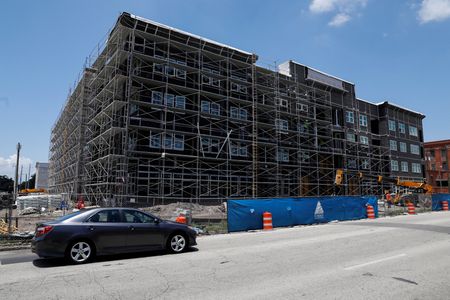By Lucia Mutikani
WASHINGTON (Reuters) – Sales of new U.S. single-family homes fell in June after three straight monthly increases, but the trend remained strong as an acute shortage of previously owned homes underpins demand.
New home sales dropped 2.5% to a seasonally adjusted annual rate of 697,000 units last month, the Commerce Department said on Wednesday. May’s sales pace was revised lower to 715,000 units from the previously reported 763,000 units. May’s sales pace was the highest since February 2022.
“The data remain consistent with and provide further confirmation of a bottoming-out in housing activity, with the three-month average of sales rising in every month since November 2022,” said Conrad DeQuadros, senior economic advisor at Brean Capital in New York.
Economists polled by Reuters had forecast new home sales, which account for a small share of U.S. home sales, would drop to a rate of 725,000 units.
New home sales are counted at the signing of a contract, making them a leading indicator of the housing market. They, however, can be volatile on a month-to-month basis. Sales increased 23.8% on a year-on-year basis in June.
With the inventory of existing homes near historically low levels and multiple offers on some properties, potential buyers are seeking out new houses, driving up homebuilding. Many homeowners have mortgage loans with rates below 5%, reducing the incentive to put their houses on the market.
The rate on the popular 30-year fixed mortgage is just under 7%, according to data from the Mortgage Bankers Association.
The shortage is also boosting house prices, which had been in retreat or declining earlier this year as higher mortgage rates pushed buyers to the sidelines. According to the National Association of Home Builders, fewer builders were offering incentives, including cutting prices to increase sales.
While the overall housing market continues to stabilize, higher mortgage rates and the renewed house price appreciation could delay a recovery.
The Federal Reserve on Wednesday raised its policy by 25 basis points to a 5.25% to 5.50% range.
Stocks on Wall Street closed little changed. The dollar fell against a basket of currencies. U.S. Treasury prices rose.
HOUSING STABILIZING
There are concerns that signs of life in the housing market could compel the Fed to push interest rates even higher, which some economists said would be a mistake. They argued that there was a huge pipeline of homes still to be completed, especially multi-family housing units.
A recession, accompanied by steep job losses and a surge in mortgage delinquencies, would force some homeowners to put their houses on the market. These factors could boost supply.
“The current equilibrium that the homebuilders are enjoying may be short-lived,” said Richard de Chazal, macro analyst at William Blair. “Given what we view as an unstable foundation, Chair (Jerome) Powell should be careful about just how much weight he places on this market.”
Last month, new home sales jumped 20.6% in the Northeast and 4.3% in the densely populated South. But they declined 13.9% in the West and tumbled 28.4% in the Midwest.
About a third of the new homes sold last month were in the $300,000 to $399,999 price bracket.
The median new house price in June was $415,400, a 4.0% drop from a year ago. The average house price was nearly $500,000.
There were 432,000 new homes on the market at the end of last month, up from 429,000 in May. Houses under construction made up 60.2% of inventory, with those yet to be started accounting for 23.1%.
At June’s sales pace it would take 7.4 months to clear the supply of houses on the market, up from 7.2 months in May.
(Reporting by Lucia Mutikani; Editing by Andrea Ricci, Paul Simao and Jonathan Oatis)





